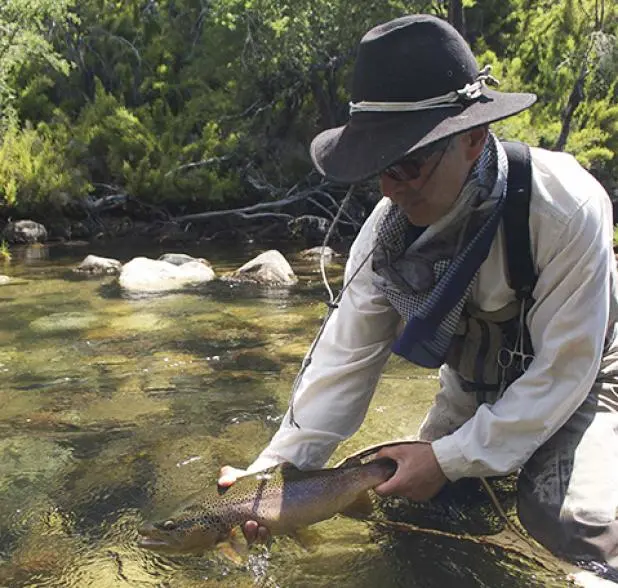Being a “catch-and-release” trout angler doesn’t necessarily mean you aren’t having an impact on the resources. In fact, if you look at some scientific data, you’ll learn that a significant percentage of caught-and-released fish (as much as 10 percent or more) die anyway. Which begs the question, who is causing more stress on the fish population, the angler who catches and releases 50 fish in a day, or the one who pops two or three in the creel for dinner? Simple math suggests the former.

There are many important factors that influence whether a trout survives after being caught or not. I’ll focus on three of them.
1. How long do you play the fish before landing it? The longer the fight, the more exhausted a fish becomes, and the more lactic acid builds up in its body. This can cause the fish to die some time later, even after you watch it swim away, seemingly no worse for the wear. Fact: the sooner you are able to release a fish after hooking it, the better its survival odds. So why we like to use feather-light tackle sometimes, I think we need to “tippet-up” when we can. A two-minute fight on 4X is better (for the fish) than the 10-minute fight on 6X. And to be totally honest, I think a good drift and presentation with heavier tippet trumps a sloppy presentation with light tippet almost every time. We like to hear the reel scream, but maybe cranking down on the drag and learning to steer fish to a reasonable landing zone quickly isn’t a bad idea.
2. Nets… ah this is a tricky one. We know that when a trout rubs around in a net, it can deplete the slime layer on its scales that help protect it from disease. But alas, I have seen many fights take substantially longer when anglers are fumbling around trying to cradle a fish or grab it by its tail. So having said what I just did about landing fish sooner, I see the value of a good net in many cases. But rubberized mesh nets are far less of a problem for trout than uncoated surfaces, or fine nets that get caught in their gills. We need to use good judgment, and ultimately leave the net attached to our back when we catch fish that can easily be brought to hand and released by plucking the fly from its mouth.
3. Air time is bad. One study by R.A. Ferguson and B.L. Tufts looked at the amount of time a fish is exposed to air after caught, and discovered that every second literally counts. Fish that were exercised but released without being held out of the water had a survival rate of 88 percent. But with 30 seconds air exposure, that dropped to 62 percent, and at one minute, it was a mere 28 percent. Makes sense. Imagine running a few laps around the track, and then dunking your head in a bucket of water. Think about those numbers when you go to take that photograph of the big trout you just landed. Try to keep those shots to 10 seconds or less, if at all possible.
I’m not suggesting by any means that catch-and-release fishing is bad. I am a catch-and-release trout angler, at least most of the time. I think the practice–done right–can ensure that the trout fishing is optimized, and great fish can be shared by many anglers. But it is more than an ethical soap box, and done poorly, it actually gives us a false sense of helping the resource, when we are really hurting it. And that can be a problem.
So long as we all fish within the regulations, whether we are catch-and-release anglers or catch-and-keep anglers, that’s just fine. But I hope more of us start thinking more in terms of quality than quantity. Maybe catching 10 trout on dry flies is better than pounding 50 fish in a day by running a synthetic worm and egg with a nymph rig beneath a strike indicator. I know that we always have, and probably always will, measured angling success with the simple “how many did you catch” question. That’s fine. But if you want to be an effective catch-and-release angler, maybe the more appropriate question should be “how many did you really let survive?”
That’s just a thought. I’m interested to hear yours.
![Field & Stream [dev]](https://images.ctfassets.net/fbkgl98xrr9f/1GnddAVcyeew2hQvUmrFpw/e4ca91baa53a1ecd66f76b1ef472932b/mob-logo.svg)

